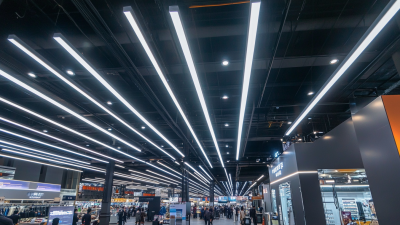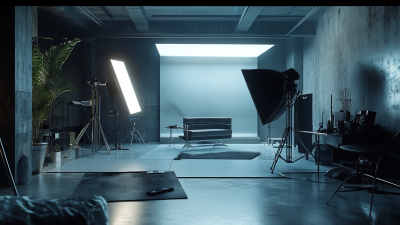How to Maximize Energy Efficiency with Led Sheets for Your Business
In today’s competitive business landscape, energy efficiency has become a critical factor for sustainability and cost reduction. One innovative solution that businesses are increasingly adopting is the use of LED sheets. These versatile lighting options not only provide superior illumination but also significantly reduce energy consumption compared to traditional lighting methods. Understanding how to maximize energy efficiency with LED sheets can transform your workspace into a bright, inviting environment while lowering operational costs. By leveraging the benefits of LED technology, businesses can enhance productivity, improve employee morale, and contribute to environmental preservation. This guide will explore practical strategies for integrating LED sheets into your business model, ensuring you achieve optimal energy savings without compromising on quality or aesthetics.

Understanding the Basics of LED Sheets and Their Benefits for Businesses
LED sheets have rapidly emerged as a game changer in the commercial lighting sector, providing significant benefits for businesses looking to enhance energy efficiency. According to a report by the U.S. Department of Energy, LED lighting can last up to 25 times longer than traditional incandescent bulbs, resulting in reduced replacement costs and lower maintenance efforts. This longevity, combined with their high efficiency — using up to 75% less energy — means that businesses can see substantial reductions in their energy bills.
Investing in LED sheets not only helps lower operational costs but also plays a role in sustainability. A study published in the Journal of Cleaner Production indicates that switching to LED can reduce greenhouse gas emissions significantly, making it an attractive option for businesses striving for greener practices.
Tips for Implementation:
- Start with a comprehensive energy audit to identify areas where LED sheets can be most effective.
- Consider dimmable LED sheets to further optimize energy use during off-peak hours.
- Explore rebates and incentives offered by local governments or utility companies to offset initial investment costs.
Assessing Energy Consumption: Identifying Areas for Improvement
Assessing energy consumption is a crucial step for businesses looking to enhance their energy efficiency using LED sheets. According to the U.S. Department of Energy, LED lighting can use up to 75% less energy than traditional incandescent lights. Businesses often overlook lighting when evaluating their overall energy usage, yet lighting can account for a significant portion of the total energy consumption—typically around 30% to 50% for commercial buildings. By assessing current lighting systems, companies can identify areas with excessive energy use and determine opportunities for improvement.
One effective method for assessing energy consumption is conducting a lighting audit. This involves evaluating the existing fixtures, their wattage, and usage patterns. For example, the Pacific Northwest National Laboratory found that by replacing fluorescent tubes with LED alternatives, organizations can achieve energy savings of about 50-60%. Additionally, integrating smart controls, such as occupancy sensors and dimmers, can further augment energy savings, with potential reductions reaching up to 40% in some cases. By pinpointing and addressing these areas, businesses can significantly cut costs and improve their sustainability footprint.

Choosing the Right LED Sheets for Specific Business Needs
When it comes to optimizing energy efficiency in your business, selecting the right LED sheets is crucial. According to the U.S. Department of Energy, LED lighting can be up to 80% more energy-efficient than traditional incandescent bulbs. This efficiency translates not just to lower utility bills but also to a reduced carbon footprint. Businesses should consider their specific lighting needs, such as brightness levels, color temperatures, and application areas, to make an informed choice.
For example, retail environments may benefit from high-lumen output LED sheets that illuminate products effectively while enhancing the overall shopping experience. Conversely, office spaces might prioritize LED sheets with warmer color temperatures to create a more inviting atmosphere. Reports from the International Energy Agency suggest that by adopting LED technology across various settings, businesses could save approximately $120 billion in energy costs globally by 2030. By choosing the right LED sheets tailored to their specific needs, companies can not only enhance their operational efficiency but also contribute to broader sustainability goals.
Maximizing Energy Efficiency with LED Sheets
This chart illustrates the potential energy savings from using different types of LED sheets in various business sectors. The data represents energy consumption in kilowatt-hours (kWh) per month for traditional lighting versus LED sheets.
Implementing LED Sheets: Best Practices for Installation and Usage
Implementing LED sheets in your business can drastically enhance energy efficiency and reduce operational costs. According to the U.S. Department of Energy, LEDs consume up to 75% less energy than traditional incandescent lighting, which can translate to significant savings on your electricity bill. When installing LED sheets, it's crucial to assess the specific lighting needs of each area in your facility. Proper placement and usage of LEDs can maximize light output while minimizing energy waste, ensuring you get the most from your investment.

Moreover, adhering to best practices during installation can further optimize performance. Ensure that the LED sheets are installed in line with the fixture design, and consider incorporating smart controls, such as dimmers and motion sensors, to further enhance energy savings. A report from the International Energy Agency highlights that integrating smart technologies can lead to an additional 30% efficiency improvement. Regular maintenance and monitoring of the LED systems also play a vital role, with well-maintained systems performing at peak efficiency and longevity, reducing replacement frequency and overall costs.
Monitoring and Evaluating Energy Savings with LED Sheets Over Time
To effectively monitor and evaluate the energy savings of LED sheets over time, businesses should implement a structured approach. This begins by establishing a baseline energy consumption measurement using traditional lighting before switching to LED sheets. Collecting data on energy usage allows organizations to compare their pre- and post-LED installation performance.
As businesses adopt LED technology, periodic evaluations should be scheduled to assess energy efficiency. Utilizing energy management software can enhance this process, providing real-time analytics on electricity usage, cost savings, and overall environmental impact. These tools can help identify patterns in energy consumption, enabling businesses to adjust usage habits and further maximize efficiency.
Moreover, regular maintenance and benchmarking against industry standards will ensure that the LED sheets continue to function optimally over time. By documenting the energy savings achieved and adjusting strategies based on these findings, businesses can not only reduce costs but also contribute to sustainable practices, reinforcing their commitment to environmental stewardship.
How to Maximize Energy Efficiency with Led Sheets for Your Business - Monitoring and Evaluating Energy Savings with LED Sheets Over Time
| Year | Initial Energy Cost ($) | Post-LED Energy Cost ($) | Annual Savings ($) | Percentage Savings (%) | Payback Period (Years) |
|---|---|---|---|---|---|
| 2020 | 10,000 | 7,500 | 2,500 | 25% | 2 |
| 2021 | 9,800 | 7,100 | 2,700 | 27.55% | 1.85 |
| 2022 | 9,600 | 6,900 | 2,700 | 28.13% | 1.85 |
| 2023 | 9,400 | 6,500 | 2,900 | 30.85% | 1.65 |
Related Posts
-

Unveiling the Best Flexible LED Panel with 15 Advanced Features for Ultimate Lighting Solutions
-

Global Market Insights for Best Recessed Lighting Toward 2025 and Beyond
-

Leading LED Linear Lighting Manufacturers from China at the 137th Canton Fair
-

How to Maximize Energy Efficiency with Recessed Lighting: Insights and Tips from Industry Data
-

Exploring the Unique Features and Applications of Diverse Lighting Solutions
-

Discover the Future: 7 Revolutionary LED Technology Trends You Can't Miss
